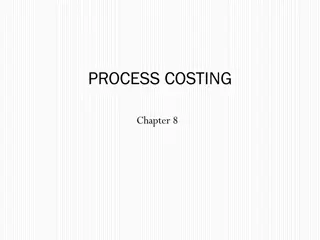Understanding Full Costing in Higher Education
Full costing in higher education involves accounting for both direct and indirect costs related to activities, projects, or cost units. It is important for efficient resource allocation, strategic decision-making, benchmarking, and transparency. By revealing the total costs involved, it provides valuable information for financial planning and decision-making in universities. This method helps in identifying who pays for the costs, whether through government funding, private contributions, or other sources.
Download Presentation

Please find below an Image/Link to download the presentation.
The content on the website is provided AS IS for your information and personal use only. It may not be sold, licensed, or shared on other websites without obtaining consent from the author. Download presentation by click this link. If you encounter any issues during the download, it is possible that the publisher has removed the file from their server.
E N D
Presentation Transcript
The SUHF-model a full costing method (The Association of Swedish Higher Education) What is full costing and why is it important? Olle H ggbom 1
There are no free lunches somebody always has to pay the bill ( in a visible or invisible way) Olle H ggbom 2
What is full costing? For an activity (project, cost unit) the full cost both direct and indirect costs should be shown Olle H ggbom 3
Direct cost: directy related to the cost unit Indirect cost: common for several or all cost units Olle H ggbom 4
Direct cost: You Get What You Pay For directy related to the cost unit Indirect cost: Real Costs of Doing Business joint for several or all cost units Olle H ggbom 5
Benefits of full costing 1. More activity based accounting 2. Efficient allocation of internal resources 3. Supports strategical management decisions 4. Benchmarking possibilities 5. A better base for negotiations and pricing decisions 6. Transparency -better understanding and trust Olle H ggbom 6
Its also important with full costing at the universities, because it givs us information about the total cost for an activity and what we have to finance in one or another way. Olle H ggbom 7
Research funding? SEK 31,7 billion 3% 0% Direct government funding 2010 16% Government research funding bodies and other public funding EU 4% 47% Private funding, swedish Private funding, foreign 30% Financial income Olle H ggbom 8
Who pays the rest of the bill? What others doesn t pay is mainly covered by government funding SEK 31,7 billion 3% 0% Direct government funding Government research funding bodies and other public funding EU 16% 4% 47% Private funding, swedish Private funding, foreign 30% Financial income Olle H ggbom 9
Swedish government guidelines Finance indirect costs in the same proportion as for direct costs! i.e. proportional financing of total costs in accordance with the SUHF-model Olle H ggbom 10
SUHF-model An accounting model for indirect costs which shows the full cost of education and of research at Higher Education institutions in Sweden. The SUHF-model is implemented at all swedish HE-institutions. Olle H ggbom 11
core operations support activities Direct costs Indirect costs Staff Operations Premises Depreciations University level Faculty level Department level Total costs (cost unit) = Direct costs + Indirect cost Olle H ggbom 12
Indirect costs support activities Management* Education- or research support* Accounting- and HR* Infrastructure and service* Library* Others* Indirect cost are carefully divided between and allocated to education or research * incl. premises Olle H ggbom 13
Indirect costs are allocated to research-projects and cost units as calculated markups On direct salaries costs (+40-50%) or On direct salaries and operating costs (+30-40%) (allocation bases, cost drivers) Olle H ggbom 14
Project calculation Salaries Operation Premises +Depreciation = direct costs + indirect costs rate % x direct costs = total costs Olle H ggbom 15
Some funders finance the total cost Olle H ggbom 16
Some funders dont cover the total cost Sorry, we can t accept the money Yes, thank You, but then we have to share the costs Olle H ggbom 17
Cost sharing (co-funding) Cost sharing = Underfinancing Is mostly financed by government funding = less room for free research. Olle H ggbom 18
core operations support activities Direct costs Indirect costs Staff Operations Premises Depreciations University level Faculty level Department level External funding Total costs (cost unit) = Direct costs + Indirect cost Co-funding Olle H ggbom 19
The important thing is that the funders agreed on the principles of full costing (that all direct and indirect costs are included). It is another thing to what extent these full costs are financed. Olle H ggbom 20
proportion - indirect costs Research 2012 100% 90% 80% 70% Share indirect costs 60% 50% 40% 30% 20% 10% 0% SDH HHS LNU KTH SH KF KKH UmU KI LTU KaU DCH LU GU LiU SU SLU OH UU HS U MdH HB HH HD HiG HV HJ HG GIH HKr CTH MAH BTH KMH MiU SUHF-statistiken 2012/Ann-Kristin Mattsson/2012-10-04 21
proportion - indirect costs education 2012 100% 90% 80% 70% 60% Share indirect costs 50% 40% 30% 20% 10% 0% SDH HHS LNU KTH DCH KKH SH KF KI LTU UmU KaU SU LU GU LiU SLU OH UU MdH HB U HS HD HG HKr HiG HH HJ HV GIH CTH BTH MAH KMH MiU SUHF-statistiken 2012/Ann-Kristin Mattsson/2012-10-04 22
proportion - indirect costs (>100 mnkr research) 35.0% 30.0% 25.0% Share indirect costs 20.0% 15.0% 10.0% 5.0% 0.0% - 500 000 1000 000 1500 000 2000 000 2500 000 3000 000 3500 000 4000 000 4500 000 5000 000 research tkr 2013-05-14 Olle H ggbom 23
Benefits of full costing 1. More activity based accounting 2. Efficient allocation of internal resources 3. Supports strategical management decisions 4. Benchmarking possibilities 5. A better base for negotiations and pricing decisions 6. Transparency -better understanding and trust Olle H ggbom 24
Financially Sustainable Universities Towards full costing in European universities 14 european countries
EUA Underfinancing is a general problem Full costing is important to show the total costs Most developed: Great Britan, Ireland, Finland, Sweden, Netherlands, USA, Australia, Canada. Olle H ggbom 26
EUA Obstacles to full costing Internal Resistance against change, New Public Management (NPM) Concerns over time-accounting Lack of support from the management External To less autonomy Lack of trust from funders No financial support for implementing full costing
EUA Success factors 1. Coordinated approach 2. Enough autonomy 3. Financial support for development and implementation 4. Funders have rules that support full cost accouting 5. Education and staff training 6. Management committment and effective internal and external communication 7. Administrative staff communicate effectively with academic staff
With full costing we will all be happy Olle H ggbom 29























